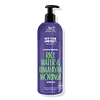What's inside
What's inside
 Benefits
Benefits

 Concerns
Concerns

 Ingredients Side-by-side
Ingredients Side-by-side

Water
Skin ConditioningSodium Lauroyl Sarcosinate
CleansingCocamidopropyl Betaine
CleansingSodium Cocoamphoacetate
CleansingLauryl Glucoside
CleansingDecyl Glucoside
CleansingSodium Cocoyl Glutamate
CleansingSodium Lauryl Glucose Carboxylate
CleansingGlycerin
HumectantPyrus Malus Fruit Extract
Skin ConditioningAloe Barbadensis Leaf Juice
Skin ConditioningChamomilla Recutita Leaf Extract
MaskingCitrus Aurantium Dulcis Peel Extract
Emulsion StabilisingCitrus Grandis Fruit Extract
AstringentCymbopogon Schoenanthus Extract
Skin ConditioningEchinacea Purpurea Extract
MoisturisingGlycine Soja Seed Extract
Skin ConditioningLavandula Angustifolia Extract
Skin ConditioningRosmarinus Officinalis Leaf Extract
AntimicrobialMacrocystis Pyrifera Extract
Skin ConditioningMangifera Indica Pulp Extract
Skin ConditioningSalix Alba Extract
Skin ConditioningXanthan Gum
EmulsifyingGlycol Distearate
EmollientPanthenol
Skin ConditioningCitric Acid
BufferingPolysorbate 20
EmulsifyingPotassium Sorbate
PreservativePhenoxyethanol
PreservativeParfum
MaskingWater, Sodium Lauroyl Sarcosinate, Cocamidopropyl Betaine, Sodium Cocoamphoacetate, Lauryl Glucoside, Decyl Glucoside, Sodium Cocoyl Glutamate, Sodium Lauryl Glucose Carboxylate, Glycerin, Pyrus Malus Fruit Extract, Aloe Barbadensis Leaf Juice, Chamomilla Recutita Leaf Extract, Citrus Aurantium Dulcis Peel Extract, Citrus Grandis Fruit Extract, Cymbopogon Schoenanthus Extract, Echinacea Purpurea Extract, Glycine Soja Seed Extract, Lavandula Angustifolia Extract, Rosmarinus Officinalis Leaf Extract, Macrocystis Pyrifera Extract, Mangifera Indica Pulp Extract, Salix Alba Extract, Xanthan Gum, Glycol Distearate, Panthenol, Citric Acid, Polysorbate 20, Potassium Sorbate, Phenoxyethanol, Parfum
Water
Skin ConditioningSodium Lauroyl Sarcosinate
CleansingSodium Cocoyl Isethionate
CleansingCocamidopropyl Hydroxysultaine
CleansingPEG-120 Methyl Glucose Dioleate
EmulsifyingGlycol Distearate
EmollientPropanediol
SolventCocodimonium Hydroxypropyl Hydrolyzed Rice Protein
Skin ConditioningOryza Sativa Extract
AbsorbentMoringa Oleifera Seed Extract
Skin ConditioningPolyquaternium-10
Tetrasodium Glutamate Diacetate
Phenoxyethanol
PreservativeEthylhexylglycerin
Skin ConditioningParfum
MaskingCitric Acid
BufferingCaramel
Cosmetic ColorantWater, Sodium Lauroyl Sarcosinate, Sodium Cocoyl Isethionate, Cocamidopropyl Hydroxysultaine, PEG-120 Methyl Glucose Dioleate, Glycol Distearate, Propanediol, Cocodimonium Hydroxypropyl Hydrolyzed Rice Protein, Oryza Sativa Extract, Moringa Oleifera Seed Extract, Polyquaternium-10, Tetrasodium Glutamate Diacetate, Phenoxyethanol, Ethylhexylglycerin, Parfum, Citric Acid, Caramel
Ingredients Explained
These ingredients are found in both products.
Ingredients higher up in an ingredient list are typically present in a larger amount.
Citric Acid is an alpha hydroxy acid (AHA) naturally found in citrus fruits like oranges, lemons, and limes.
Like other AHAs, citric acid can exfoliate skin by breaking down the bonds that hold dead skin cells together. This helps reveal smoother and brighter skin underneath.
However, this exfoliating effect only happens at high concentrations (20%) which can be hard to find in cosmetic products.
Due to this, citric acid is usually included in small amounts as a pH adjuster. This helps keep products slightly more acidic and compatible with skin's natural pH.
In skincare formulas, citric acid can:
While it can provide some skin benefits, research shows lactic acid and glycolic acid are generally more effective and less irritating exfoliants.
Most citric acid used in skincare today is made by fermenting sugars (usually from molasses). This synthetic version is identical to the natural citrus form but easier to stabilize and use in formulations.
Read more about some other popular AHA's here:
Learn more about Citric AcidGlycol Distearate serves as a pearlizing or opacifying agent in cosmetic products.
It's often included in cleansers and haircare products to give them a lustrous or shimmering appearance.
It is derived from stearic acid, a natural fatty acid commonly found in vegetable oils and animal fats.
Glycol Distearate isn't fungal acne safe.
Learn more about Glycol DistearateParfum is a catch-all term for an ingredient or more that is used to give a scent to products.
Also called "fragrance", this ingredient can be a blend of hundreds of chemicals or plant oils. This means every product with "fragrance" or "parfum" in the ingredients list is a different mixture.
For instance, Habanolide is a proprietary trade name for a specific aroma chemical. When used as a fragrance ingredient in cosmetics, most aroma chemicals fall under the broad labeling category of “FRAGRANCE” or “PARFUM” according to EU and US regulations.
The term 'parfum' or 'fragrance' is not regulated in many countries. In many cases, it is up to the brand to define this term.
For instance, many brands choose to label themselves as "fragrance-free" because they are not using synthetic fragrances. However, their products may still contain ingredients such as essential oils that are considered a fragrance by INCI standards.
One example is Calendula flower extract. Calendula is an essential oil that still imparts a scent or 'fragrance'.
Depending on the blend, the ingredients in the mixture can cause allergies and sensitivities on the skin. Some ingredients that are known EU allergens include linalool and citronellol.
Parfum can also be used to mask or cover an unpleasant scent.
The bottom line is: not all fragrances/parfum/ingredients are created equally. If you are worried about fragrances, we recommend taking a closer look at an ingredient. And of course, we always recommend speaking with a professional.
Learn more about ParfumPhenoxyethanol is a preservative that has germicide, antimicrobial, and aromatic properties. Studies show that phenoxyethanol can prevent microbial growth. By itself, it has a scent that is similar to that of a rose.
It's often used in formulations along with Caprylyl Glycol to preserve the shelf life of products.
Sodium Lauroyl Sarcosinate is a cleansing agent and emulsifier. It is a surfactant derived from sarcosine, and a common source is coconut oil.
As a surfactant, Sodium Lauroyl Sarcosinate helps lift dirts, oil, and other molecules to be washed away. In leave-on products, this ingredient is used as an emulsifier. Emulsifier help prevent ingredients such as oils and waters from separating.
Sodium Lauroyl Sarcosinate is also commonly found as a foaming agent in shampoo, toothpaste, and shaving foam. It is amphiphilic, meaning it loves both water and fats.
Water. It's the most common cosmetic ingredient of all. You'll usually see it at the top of ingredient lists, meaning that it makes up the largest part of the product.
So why is it so popular? Water most often acts as a solvent - this means that it helps dissolve other ingredients into the formulation.
You'll also recognize water as that liquid we all need to stay alive. If you see this, drink a glass of water. Stay hydrated!
Learn more about Water